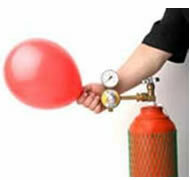The Avogadro Hypothesis, proposed in 1811 by Amedeo Avogadro, says that:
Equal volumes, of any gases, under the same pressure and temperature conditions, present the same quantity of substances in moles (molecules).
This law is related to the molar volume of gases.
Concept of molar volume of gases: volume occupied by one mole of any gas, at a given pressure and temperature.
Considering that the molar volume for any gas is 22.4 L/mol, we have that the relationship between the volume and the number of mol is constant:
V = K
N
The equation expresses that 22.4 liters of any gas have 6.02 x 1023 molecules (1 atm and 0 °C conditions).
For example:
If we fill a balloon with Helium (He) gas we will have a volume of 22.4 liters and 6.02 x 1023 gas molecules. But if we inflate the same balloon until it occupies the same volume, only with another gas, hydrogen (H2), for example, how many molecules of H2 would we have? Same amount = 6.02 x 1023 molecules.
The volume is practically the same for any gas, considering that the size of a gas molecule is negligible compared to the empty space between them.
By Líria Alves
Graduated in Chemistry
Brazil School Team
See more! Molar volume of gases
General chemistry - Chemistry - Brazil School
Source: Brazil School - https://brasilescola.uol.com.br/quimica/relacao-entre-lei-avogadro-gases.htm

